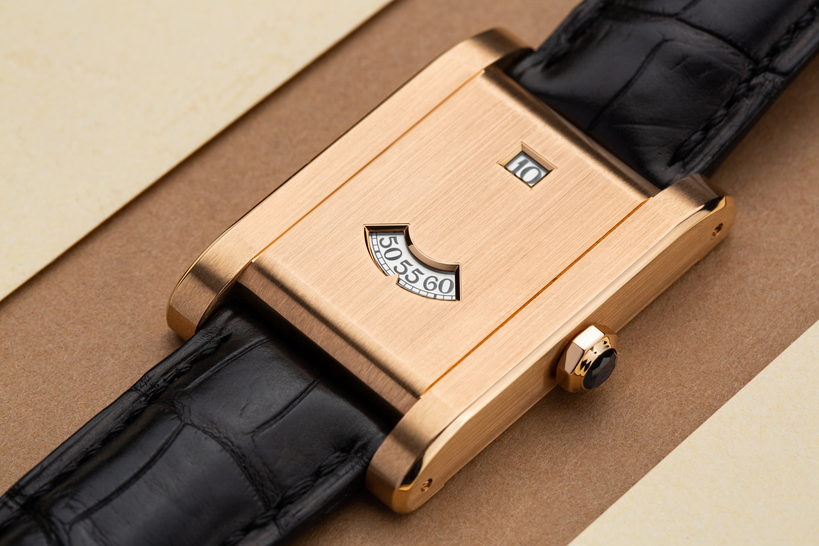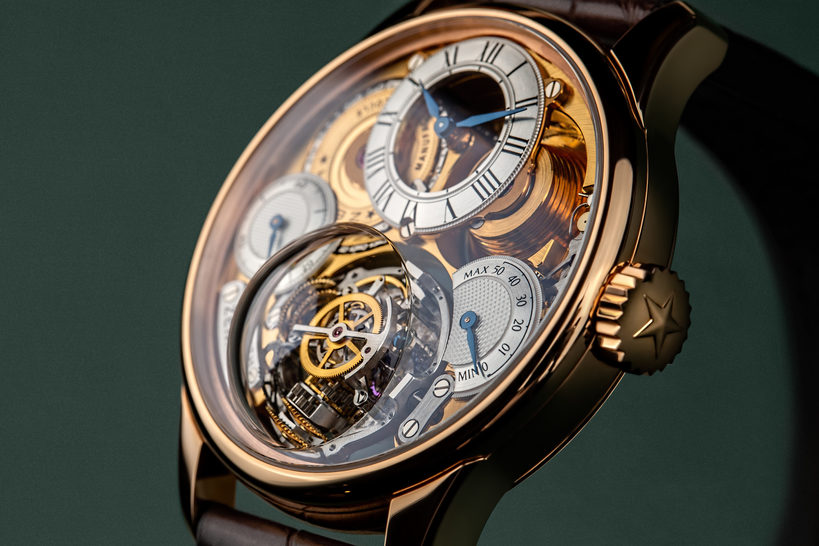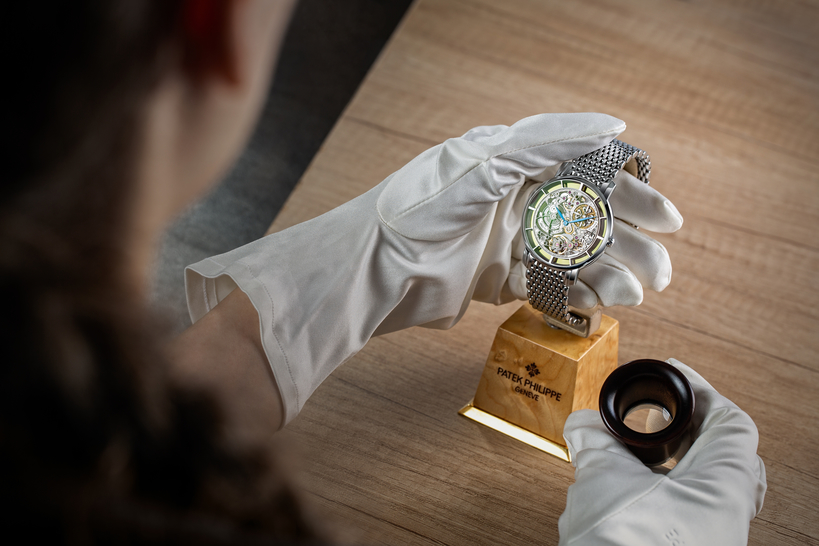Six best dress watches by major watchmakers in the first half of the year.
The phrase “timeless classic” can be used to describe all art forms, and certainly haute horlogerie. Yet once every ten years or so, the major watchmakers still update their collections of strictly classic, three-hand dress watches. Feast your eyes on our pick of the most interesting novelties by the most prestigious manufacturers.
Patek Philippe Calatrava Ref. 6196P
The world’s number-one dress watch, Patek Philippe’s Calatrava Ref. 5196, was discontinued after its eighteen-year run from 2004 to 2022. Now the long-awaited replacement model has arrived: the latest-generation Calatrava Ref. 6196.
The digits “96” at the end of the reference number signify that it’s the flagship model. Only this model is a direct descendant of the original iconic Ref. 96 from 1932. So bar the stark contrast of the new model’s salmon dial with anthracite markers, the visual changes to Ref. 5196 have been subtle.
The millimeter difference in diameter between the case sizes is invisible to the naked eye — Ref. 6196 has grown to 38 mm. And the case has grown thicker too: 9.33 mm compared to the previous 7.68 mm. Other than that, it’s also a three-part case with the same dauphine hands and the same faceted obus-style hour markers...
The main difference lies inside the case. Good old caliber 215 PS has been replaced by the new 30-255 PS. It’s more powerful with two mainspring barrels, which is why it’s almost a centimeter wider in diameter at an overall 31 mm compared to the 21.9-mm 215 PS.
This allowed the power reserve to be increased to 65 hours (the 215 PS offered 44 hours). Interestingly, the height of the movement is the same as the 215 at just 2.55 mm. In other words, the case has only grown to meet aesthetic demands. The thicker case suits the first platinum version of Ref. 6196 better.
The new platinum Calatrava with a salmon dial, or rather “rose-gilt opaline”, as Patek Philippe prefers to call it, has a very attractive price: exactly CHF 40,000. Could you say that the iconic Calatrava is welcoming a new era with new colors? Yes, absolutely. It’ll be even more interesting to see the simple Ref. 6169 models without the diamond set in their casebands at 6 o’clock.
Vacheron Constantin Traditionnelle Manual-Winding
The classic models in the Traditionnelle collection that was launched for the watchmaker’s 270th anniversary don’t look any different from the ones introduced last year at first glance. They share the same case dimensions at 38 mm in diameter and 7.77 mm in height.
The same VC 4400 AS/270 manufacture movement, silver-toned dials, and dovetail “dauphine” hands. Only when you take a closer look, you’ll find that the dial is decorated with an unusual pattern, developed especially for the 270th anniversary, featuring a Maltese cross motif — Vacheron Constantin’s logo.
The hands may be the familiar shape, but now they’re clearly defined in the center with strikingly sharp edges. And given that they’ve also been polished to perfection, these edges reflect light onto the surface of the dial and give the pattern a different look at different times of the day.
The manually wound VC 4400 AS/270 movement is also decorated with a unique take on the Côtes de Genève (Geneva waves) — a pattern of fine, winding lines, reminiscent of a human fingerprint. The engravers have drawn inspiration for this pattern from examples of Vacheron Constantin timepieces that date back 270 years, and they’ve dubbed it côte unique.
So you could say that the new model showcases many changes, especially for a classic watch. But the price has barely changed at all, which is definitely a perk. The platinum model costs USD 36,200, while the rose-gold version is USD 26,100.
That’s even cheaper than a platinum Rolex 1908! It’s an irresistible offer. Availability will be limited to just 740 models (370 of each version). The watch can only be purchased via Vacheron Constantin’s boutiques.
Breguet Classique Souscription 2025 Ref. 2025BH/28/9W6
The watchmaking house founded by the great Abraham-Louis Breguet is marking its 250th anniversary this year. The novelties dedicated to this milestone date include a classic watch, but it isn’t a three-hander, it only has one hand to point the hours. Abraham-Louis Breguet made a mammoth contribution to the development of watchmaking and haute horlogerie.
He invented the tourbillon, automatic winding, the Pare-chute system considered the first shock-absorbing mechanism, and the hairspring with the characteristic Breguet flat terminal curve. But that’s not all that Breguet achieved.
By developing his uniquely shaped trademark hands, numerals, and an entire system to make it harder for con artists to earn a living by making forgeries, Breguet was basically the first watchmaker in the world to implement a branding strategy.
The great watchmaker of many firsts also employed a subscription system for his pocket watches to more or less balance the production and financial demands. Needless to say, you could only subscribe to obtain simple, classic timepieces, while the creation of complicated pieces required an in-depth conversation with the watchmaker himself or representatives of his company in the client’s country.
From the time the “Souscription” watch was introduced in 1796, a total of approximately 700 of these pocket watches were sold. It was an impressive number in those days. Today’s anniversary wristwatch is a smaller take on the Breguet “Souscription” pocket watch.
The case measures 40 mm in diameter, compared to the 61-mm original, and the new watch is 10.8 mm in height. But the design is absolutely identical. The same white, Grand Feu enamel dial bears the same blued-steel hand, numerals, and indexes. Even the construction of the new hand-wound VS00 caliber echoes the architecture of a two-hundred-year old pocket watch movement.
The center is dominated by the imposing wheel of the large central ratchet, which is engraved with the watchmaker’s handwriting, taken from a brochure that advertised the “Souscription” pocket watches. The four most important wheels in the gear train lead to the balance wheel at 6 o’clock. The movement really is big: 35.2 mm in diameter.
The balance spring with the Breguet overcoil is made of the trademark alloy Nivachron and oscillates at a frequency of 21,600 vph (3 Hz). The power reserve generated by the single mainspring barrel is a staggering 96 hours — four days! And there’s one more extremely important detail.
The case for the wristwatch is made of the latest proprietary alloy, Breguet gold. It’s 75 % yellow gold, while the remaining quarter is palladium, silver, and copper, which prevent darkening and discoloration, and make the surface more resistant to scratches and damage.
Breguet gold has a characteristic shine and tone. It’s a subscription watch in name alone, as it can be purchased through Breguet boutiques, which are part of the Swatch Group. Availability of the series is unlimited, which is another surprise. The price including taxes is CHF 45,000.
Rolex Perpetual 1908 Ref. 52506
This remarkable watch may have been launched last year, but there are no other strictly classic dress watches in Rolex’s line right now, so it’s only fair to include it in our pick. The appearance of the Perpetual 1908 in a platinum 38-mm case was the watch industry giant’s biggest talking point last year.
The collection was generally met with mixed reactions when it was introduced to the market in 2023. Collectors couldn’t quite understand why Rolex had suddenly decided to enter the market for classic black-tie watches. Surely the manufacture couldn’t compete in the same league as Patek Philippe’s Calatrava or Vacheron Constantin’s Patrimony.
But the designers at Rolex worked hard on this model, filling the space on the dial blank with a guilloché rice-grain motif. Another artistic nuance is that the “chemin de fer” minute track runs between two rings of guilloché.
Rolex also describes the extremely traditional method they’ve chosen to decorate the dials: the dials are engine turned the same way watchmakers in the 18th century would configure a graver on a typical lathe, then manually set it in motion. And all of this is done at their modern, ultra-high-tech facility!
Caliber 7140 was the first to combine the trademark Syloxi silicon hairspring with a patented Chronergy escapement. The resulting “Superlative Chronometer” movement runs at a frequency of 4 Hz (28,800 vph) with a 66-hour power reserve. But the price of the platinum novelty makes it even more astonishing: USD 30,900.
After all, the Tudor Black Bay 58 in a gold case is more expensive at USD 32,100. Moreover, the price isn’t the only reason why this watch is worth buying. The Perpetual 1908 Ref. 52506 will grow more valuable over time as the first Rolex guilloché dial.
Biver Automatique
A beautiful luxury watch has been made by the company that bears the name of the greatest revitalizer and promoter of modern watchmaking, Jean-Claude Biver. The multi-layer rose-gold dial looks so unconventional laid out in a ripple of circles: a second and minute track, where each calibration is also divided into four fractions, an hour track, the spaces in between, and of course, the center disk.
Each ring has its own individual brushed pattern, and they all come together to create a contrasting relief and play on light. The finishing on the movement is simply outstanding, featuring bridges covered with ornate Clou de Paris guilloché patterns instead of the usual Cotes de Genève finishing.
And isn’t the pattern on the micro-rotor developed for this watch remarkable? The specs are also splendid for the automatic JCB-3 movement with its unusual balance frequency of 25,200 vph (3.5 Hz) and a 68-hour power reserve.
But in the eyes of collectors, all of this splendor and magnificence will be undercut by the fact that it isn’t a manufacture movement — it’s a standard caliber developed with Dubois-Depraz, who many small brands that don’t have their own manufactures go to for their base movements. About 25 years ago, a similar situation had a negative impact on the reputation of Breguet’s watches in collectors’ circles.
No matter how hard Mr. Nicolas Hayek Sr. tried to explain that the ЕТА 2824 base movement came in 19 different variations and descendants from standard to luxury, so you can’t say that the Breguet Classique watch for EUR 10,000 runs on the same movement as Tissot’s Seastar for EUR 250, fans’ enthusiasm for the brand that had just been revived was extinguished.
Nevertheless, Biver is asking for a staggering CHF 75,000 for the version in a 39-mm rose-gold case and CHF 78,000 for the platinum edition on a leather strap. With all due respect for Jean-Claude Biver’s big name and the magnificent execution of the Biver Automatique, you could still say it’s a bit too much.
Chopard L.U.C Quattro Mark IV
The debut of this watch at Watch & Wonders in April last year wasn’t met with as much fanfare as the novelties by Vacheron Constantin, Patek Philippe, and Rolex, but we’d genuinely like to congratulate Chopard and its Co-President Karl-Friedrich Scheufele in particular on the launch of the remarkable Chopard L.U.C Quattro Mark IV.
This is essentially a model dedicated to the 25th anniversary of the first automatic L.U.C. caliber. As a quick reminder, these movements are named after the founder of luxury watch and jewelry company, Louis-Ulysses Chopard (1836–1915). It’s worth pointing out here that the watchmakers at Chopard created a hand-wound version of the L.U.C for this model.
At the same time, they made every effort to ensure that winding the L.U.C 98.09-L with all of its four mainspring barrels wouldn’t be agonizingly time-consuming. Needless to say, scrapping the self-winding mechanism has made the movement look better. It’s been finished and decorated to the highest standards and bears the Poinçon de Genève quality hallmark.
Why no Qualité Fleurier certification? Because that’s how the creators wanted to do things. At the end of the day, the Geneva Seal is a more recognizable mark of excellence. Of course, the hand-wound version of the movement has maintained all the old core specs of the original Quattro design.
It has four mainspring barrels that provide a nine-day power reserve, a constant-force device, and a balance frequency of 28,800 vph. L.U.C 98.09-L measures just 3.75 mm in height. That’s very lean for a powerful engine with four mainspring barrels. It allowed the 39-mm platinum case to be kept to 10.4 mm in height.
The outstanding L.U.C Quattro Mark IV dress watch is the fruit of a single decision on design — moving the 9-day power reserve indication from the dial to the caseback. Obviously, the designers wanted to draw attention to the 216-hour power reserve on previous versions. But now the watch lives up to all the cannons of black-tie watches.
We’re not going to claim that the L.U.C Quattro Mark IV is now the best Calatrava on the market, as some experts have already proclaimed. But the model has every chance of gaining entry for Chopard to the elite, members-only club of manufacturers known for their classic luxury watches.
Availability is unlimited to meet the expected high demand. The price has also been determined very shrewdly: USD 47,900 for the platinum edition and USD 38,400 for the version in a case made of signature ethical rose gold.
What Are Dress Watches Now?
If you were to generalize based on these novelties, you could say that strictly classic models are almost non-existent these days. All of the models have some stand-out, non-classical features. Whether it’s a large or even double mainspring barrel to increase the power reserve, a striking colorway for the minute track, a relief dial, or an unusual combination of guilloché patterns...
Four models out of six are equipped with hand-wound movements. The value of hand-wound movements today isn’t just the opportunity to pay tribute to traditions, it’s also an opportunity to decorate the movement to the max.
The price for a classic watch is rapidly increasing, and you get the impression that the manufacturers have plotted to set the benchmark at CHF 40,000. At the same time, newcomers are vying to take it up a notch, closer to CHF 70,000. That is why, within the bigger picture, the Rolex 1908 and Vacheron Constantin’s Traditionnelle Manual-Winding look invincibly irresistible.






















